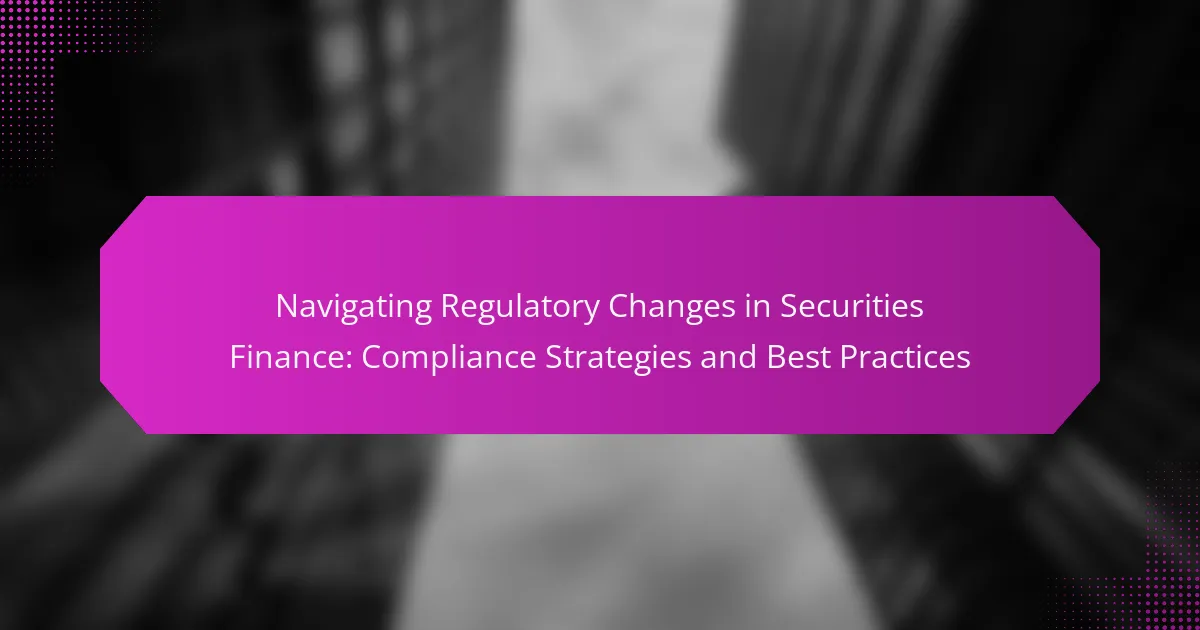The article focuses on regulatory changes in the securities finance sector, primarily highlighting the Securities Financing Transactions Regulation (SFTR) in the EU and the updated Basel III framework, which impact transparency and capital requirements. It discusses the implications of the Dodd-Frank Act in the U.S. on collateral management and risk mitigation practices. The article outlines compliance strategies, including the implementation of risk management frameworks, regular audits, employee training, and the use of technology to enhance compliance. Additionally, it addresses the challenges organizations face in navigating these regulatory changes, such as understanding complex regulations and managing increased compliance costs.

What are the key regulatory changes affecting securities finance?
Key regulatory changes affecting securities finance include the implementation of the Securities Financing Transactions Regulation (SFTR) in the EU. SFTR mandates transparency in securities lending and repurchase agreements. It requires firms to report details of these transactions to trade repositories. Another significant change is the updated Basel III framework, which impacts capital requirements for banks engaged in securities financing. This framework aims to reduce systemic risk in the financial system. Additionally, the Dodd-Frank Act in the U.S. has introduced reforms that affect collateral management and risk mitigation practices. These regulations collectively enhance oversight and reduce risks in the securities finance market.
How do these regulatory changes impact compliance requirements?
Regulatory changes directly increase compliance requirements for firms in securities finance. These changes often introduce new rules and standards that must be adhered to. For example, enhanced reporting obligations may require firms to implement new data collection processes. Additionally, changes may necessitate revisions to existing compliance programs and policies. Firms may also face stricter penalties for non-compliance, increasing the urgency to adapt. The Financial Industry Regulatory Authority (FINRA) reported that firms must allocate more resources to ensure compliance with evolving regulations. As a result, organizations may need to invest in training and technology to meet these new demands effectively.
What specific regulations have been introduced recently?
Recent regulations introduced in securities finance include the Securities and Exchange Commission’s (SEC) amendments to Rule 10b5-1. This rule aims to enhance transparency in insider trading by requiring companies to disclose more information about their stock buyback plans. Additionally, the Financial Industry Regulatory Authority (FINRA) has implemented new reporting requirements for securities lending transactions. These changes are designed to improve market integrity and investor protection. In 2023, the SEC also proposed new rules regarding the use of derivatives by investment funds, aiming to mitigate systemic risks. These regulations reflect a broader trend toward stricter oversight in the securities finance industry.
How do these regulations differ from previous ones?
These regulations differ from previous ones by introducing stricter compliance requirements and enhanced transparency measures. They mandate more detailed reporting of securities transactions. Previous regulations had less stringent reporting standards and allowed for greater discretion. The new rules also impose higher penalties for non-compliance compared to earlier regulations. Additionally, they focus on risk management practices that were not emphasized before. For instance, the integration of technology in compliance processes is now a key requirement. These changes reflect a shift towards a more proactive regulatory environment in securities finance.
Why is it important to stay updated on regulatory changes?
Staying updated on regulatory changes is crucial for compliance and risk management. Regulatory frameworks frequently evolve, impacting operational practices. Non-compliance can lead to legal penalties, financial losses, and reputational damage. For instance, the implementation of the Dodd-Frank Act introduced significant changes in financial regulations. Firms that fail to adapt may face increased scrutiny from regulators. Additionally, being informed allows organizations to anticipate changes and adjust strategies proactively. This adaptability can enhance competitive advantage in the securities finance sector. Regular updates also ensure alignment with best practices and industry standards.
What risks are associated with non-compliance?
Non-compliance with regulatory standards poses significant risks. These risks include financial penalties, which can reach millions of dollars depending on the severity of the violation. Organizations may also face legal repercussions, including lawsuits and sanctions from regulatory bodies. Additionally, non-compliance can lead to reputational damage, causing a loss of trust among clients and partners. This can result in decreased business opportunities and revenue. Furthermore, operational disruptions may occur as companies scramble to rectify compliance failures. According to a 2021 report by the Association of Certified Financial Crime Specialists, 30% of organizations reported increased scrutiny from regulators due to non-compliance issues. This underscores the critical importance of adhering to regulatory requirements in the securities finance sector.
How can regulatory changes affect market stability?
Regulatory changes can significantly affect market stability by altering the rules governing financial transactions. These changes can lead to increased compliance costs for firms, which may reduce liquidity in the market. For example, the implementation of the Dodd-Frank Act in 2010 increased reporting requirements for derivatives, impacting trading volumes. Additionally, regulatory changes can create uncertainty among investors, leading to volatility. Historical data shows that markets often react negatively to unexpected regulatory announcements, as seen during the financial crisis of 2008. Overall, the nature and timing of regulatory changes play a crucial role in determining market stability.

What compliance strategies can be employed in securities finance?
Compliance strategies in securities finance include implementing robust risk management frameworks. These frameworks help identify and mitigate potential regulatory risks. Regular audits and compliance checks ensure adherence to regulations. Training programs for employees promote awareness of compliance requirements. Additionally, utilizing technology for monitoring transactions enhances compliance effectiveness. Collaboration with legal experts provides clarity on evolving regulations. Establishing clear reporting channels aids in transparency and accountability. These strategies collectively support adherence to regulatory standards in securities finance.
How can organizations assess their current compliance status?
Organizations can assess their current compliance status through a systematic evaluation process. This process typically includes reviewing internal policies and procedures against regulatory requirements. Organizations should conduct regular audits to identify gaps in compliance. They can also implement compliance management software to track adherence to regulations. Engaging with compliance experts can provide additional insights. Benchmarking against industry standards helps organizations understand their position. Utilizing employee training ensures that staff are aware of compliance obligations. Continuous monitoring of regulatory updates is essential for maintaining compliance.
What tools and frameworks can assist in compliance assessment?
Compliance assessment can be assisted by various tools and frameworks. Popular frameworks include ISO 19600 for compliance management systems and COSO for internal control. Tools like GRC (Governance, Risk, Compliance) software streamline compliance processes. Additionally, compliance management platforms, such as ComplyAdvantage and LogicGate, help automate assessments. These tools facilitate tracking regulatory changes and managing documentation. Studies show that organizations using GRC tools see improved compliance efficiency by up to 30%.
How can organizations identify gaps in their compliance?
Organizations can identify gaps in their compliance by conducting regular compliance audits. These audits assess adherence to regulatory requirements and internal policies. They highlight areas where practices may fall short. Organizations can also utilize risk assessments to pinpoint vulnerabilities. This involves analyzing processes and controls for potential weaknesses. Additionally, benchmarking against industry standards can reveal discrepancies. Engaging with compliance technology solutions aids in tracking regulatory changes. These tools can automate monitoring and reporting processes. Training employees on compliance updates ensures everyone is informed. Regular updates and communication foster a culture of compliance.
What best practices should be followed for effective compliance?
Effective compliance requires a structured approach to regulatory adherence. Organizations should establish clear compliance policies and procedures. Regular training for employees ensures they understand their compliance responsibilities. Conducting routine audits helps identify and address compliance gaps. Utilizing technology can streamline compliance processes and improve accuracy. Maintaining open communication with regulators fosters transparency and trust. Documenting compliance efforts provides a clear record for audits and inspections. Engaging with industry best practices can enhance overall compliance strategies.
How can training and education improve compliance efforts?
Training and education can significantly enhance compliance efforts by equipping employees with the necessary knowledge and skills. Well-structured training programs clarify regulatory requirements and organizational policies. They foster a culture of compliance by emphasizing the importance of adherence to regulations. Continuous education keeps staff updated on changes in laws and regulations. This proactive approach reduces the risk of violations and associated penalties. Research indicates that organizations with robust compliance training programs see a 50% reduction in compliance breaches. Effective training also improves employee confidence in handling compliance-related issues. Overall, training and education create a more informed workforce, leading to better compliance outcomes.
What role does technology play in enhancing compliance strategies?
Technology plays a crucial role in enhancing compliance strategies by automating processes and improving accuracy. It enables real-time monitoring of transactions, ensuring adherence to regulations. Advanced data analytics helps identify potential compliance risks before they escalate. Machine learning algorithms can analyze vast datasets to detect anomalies and flag suspicious activities. Automated reporting tools streamline compliance documentation, reducing human error. Furthermore, technology facilitates efficient training and communication regarding compliance policies within organizations. According to a report by Deloitte, 56% of organizations use technology to improve compliance efficiency. This demonstrates the growing reliance on technology in compliance frameworks.

What are the challenges in navigating regulatory changes?
Navigating regulatory changes presents several challenges. Organizations often face difficulties in understanding new regulations. The complexity of legal language can create confusion. Frequent updates to regulations require constant monitoring. This can strain resources and divert attention from core business activities. Compliance costs can increase significantly due to these changes. Training staff on new compliance requirements adds to operational burdens. Additionally, non-compliance risks can result in severe penalties. These challenges necessitate robust compliance strategies to effectively manage regulatory changes.
How can organizations overcome common compliance challenges?
Organizations can overcome common compliance challenges by implementing robust compliance management systems. These systems help streamline processes and ensure adherence to regulations. Regular training programs for employees enhance awareness of compliance requirements. Utilizing technology, such as compliance software, automates monitoring and reporting tasks. Conducting regular audits identifies gaps in compliance practices. Engaging with legal experts provides insights into evolving regulations. Establishing clear communication channels fosters a compliance culture within the organization. These strategies collectively enhance an organization’s ability to navigate complex regulatory environments effectively.
What strategies can be implemented to manage compliance costs?
Implementing strategies to manage compliance costs involves several key approaches. Organizations can streamline processes by adopting automated compliance management systems. These systems reduce manual workload and minimize errors. Regular training programs for employees enhance awareness of compliance requirements. This proactive approach can prevent costly violations. Conducting a thorough risk assessment helps identify areas with high compliance costs. Targeting these areas can lead to significant savings. Engaging with compliance consultants can provide expert insights tailored to specific needs. According to a 2020 report by Deloitte, firms that invest in compliance technology see a return on investment through reduced fines and penalties. By prioritizing these strategies, organizations can effectively manage and reduce compliance costs.
How can organizations ensure timely adaptation to regulatory changes?
Organizations can ensure timely adaptation to regulatory changes by implementing a proactive compliance strategy. This involves continuously monitoring regulatory developments relevant to their industry. Regular training for staff on compliance requirements is essential. Establishing a dedicated compliance team can help manage and interpret new regulations. Utilizing technology for tracking and reporting compliance can streamline processes. Additionally, engaging with regulatory bodies can provide insights into upcoming changes. According to a Deloitte survey, organizations with proactive compliance strategies are 30% more likely to adapt quickly to regulatory changes.
What resources are available for staying informed on regulatory updates?
Regulatory updates can be tracked through various resources. Government websites provide official information on new regulations. Industry associations often publish newsletters and reports. Legal firms frequently offer insights through blogs and webinars. Trade publications cover changes in regulations relevant to the sector. Social media platforms can also be useful for real-time updates. Networking with professionals in the field can lead to valuable information sharing. Online forums and discussion groups provide community insights on regulatory changes. These resources collectively help individuals stay informed about regulatory updates effectively.
How can industry associations support compliance efforts?
Industry associations can support compliance efforts by providing resources, guidance, and training to their members. They often develop best practice guidelines that help organizations understand regulatory requirements. These associations may also offer workshops and seminars focused on compliance topics. Additionally, they can facilitate networking opportunities for members to share compliance strategies. Industry associations frequently engage with regulators to advocate for practical compliance frameworks. They may publish white papers and research that clarify complex regulations. By creating a platform for discussion, they help members stay informed about regulatory changes. This support ultimately strengthens the overall compliance culture within the industry.
What role do legal advisors play in navigating regulatory changes?
Legal advisors play a crucial role in navigating regulatory changes. They provide expert guidance on legal compliance and risk management. Legal advisors analyze new regulations and assess their impact on businesses. They help organizations develop strategies to adapt to these changes. This includes drafting policies and procedures to ensure compliance. Legal advisors also offer training and support to staff on regulatory matters. Their insights help mitigate legal risks associated with non-compliance. Overall, legal advisors are essential for maintaining regulatory adherence in a dynamic environment.
What practical tips can be implemented for ongoing compliance success?
Establishing a comprehensive compliance program is essential for ongoing compliance success. This program should include regular training for employees on regulatory requirements. Conducting frequent audits helps identify potential compliance gaps. Implementing a robust reporting mechanism encourages transparency and accountability. Staying updated on regulatory changes is crucial for timely adjustments. Collaborating with legal experts ensures interpretations of regulations are accurate. Utilizing compliance management software can streamline processes and documentation. Finally, fostering a culture of compliance within the organization enhances overall adherence to regulations.
The main entity of this article is regulatory changes in securities finance. The article provides an overview of key regulatory developments, including the Securities Financing Transactions Regulation (SFTR), Basel III framework updates, and amendments to the Dodd-Frank Act, highlighting their impact on compliance requirements and market stability. It discusses the challenges organizations face in adapting to these regulations, the importance of staying updated, and the risks associated with non-compliance. Additionally, the article outlines effective compliance strategies, tools, and best practices that organizations can implement to navigate the evolving regulatory landscape successfully.
